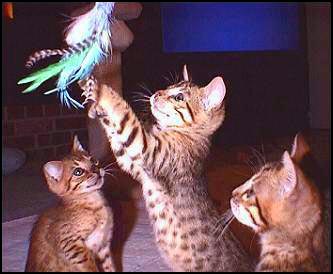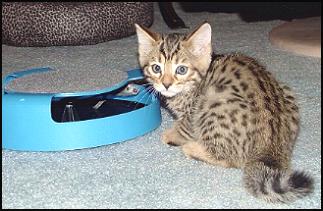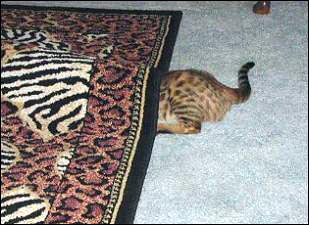
Foothill Felines Bengal Kittens Playing; by Rich Poeschel

In America, the feline has officially replaced the canine as the most popular pet and the beloved pet of choice. More families in the USA have cats now than dogs - and the majority of families with cats have more than one feline sharing their home. As more and more people are realizing the high risks in these modern times of letting their cat roam outdoors - (the current statistics are very grim in that outdoor only and indoor/outdoor cats without human supervision now live an average of only 2 to 3 years, versus an average of 16 to 17 years for indoor only cats), in order to keep our cats healthy and safe, we are keeping them confined indoors. It is not a coincidence, however, that as this change has taken place, the incidence of feline behavior problems such as self-mutilation, excessive self-licking, marking with urine or feces, and loud, compulsive vocalization, has been on the rise - all with no apparent physical or medical cause.
This phenomenon is not limited to house cats, but is also happening in zoos, and other areas and parks where felines are confined. Behaviorists at the San Diego Zoo, however, have discovered that simply by adding some safe, creative challenges each day within the enclosures of their Indo-Chinese Tigers, for example, keep these felines stimulated, both physically and mentally, and they are happier and live longer, without displaying some of the same compulsive behaviors as their indoor domestic feline relatives.
Boredom, loneliness, and a lack of challenge can be extremely stressful to cats. The feline by nature is inquisitive, social, and playful, and when their lives become so isolated, without adventures to observe or participate in, and without any trouble to get into or new things in their environment to explore, they can get depressed, and perhaps even feel no sense of purpose to their lives. This of course, can lead them to becoming lethargic and more susceptible to illness.

So, what are the options available for providing more stimulation for your own indoor cat?? The two key words that most feline behaviorists agree upon seem to be: "variety" and "randomness". Remember that indoor only cats left alone all day don't get to hear their humans voices, observe their humans interacting, witness visitors, hear appliances, phones, etc., or even receive those pats on the head and cuddles. Quite often a relatively simple solution is to - get another cat!! Taking care of 2 felines is really not much more work than taking care of one, and they can definitely keep each other company when their humans are away by wrestling, chasing each other, grooming each other, talking to each other, sleeping together, etc.
Another solution is - TOYS!! A variety of toys, given sporadically, then hidden for awhile so they don't lose their novelty is a MUST for indoor cats. Toys don't have to be expensive, either. Most cats love to chase wadded up aluminum foil, and chomp on plastic drinking straws. You can try hiding your cat's favorite toys before you leave in the morning, and create a sort of "treasure hunt" for him, which will engage his love of the hunt. (Make sure he sees you hiding at least a few of the toys!!) A special new toy with fresh catnip will often keep your cat entertained for hours - be aware that most catnip sold in pet stores is old and does not have the freshness needed for most cats to truly have a reaction to it. Fresh catnip is perfectly safe, and our adult cats love having "catnip parties" all by themselves, where they happily tear away at the toy, releasing more and more of the catnip, which they then roll in ecstatically!!
There are some motorized toys that are lots of fun, as long as you don't overdo them. These toys will often have a fur tail or look like a small mouse or rodent, but move erratically, just like a real "prey" would in the wild. This can really get your cat excited and involved in the process of trying to "catch" this unusual prey. Another fun and inexpensive thing to do is to build a "maze" out of paper grocery bags (remove any handles, of course, and use tape rather than staples for safety). My son used to do this when he was younger, sometimes attaching 20 or more paper bags, with holes cut out so that the paper bag maze would wind in and our all around our living room!! Of course, little treats and toys can be hidden along the way, and several ways "out" of the maze are provided, too.

Try setting your television (or video cassette recorder) to turn on at certain times of the day while you are away, to sports stations, or animal programs that your kitty might find interesting. Or, keep the radio turned on low a couple of days a week. Remember - VARIEY and RANDOMNESS!! Also try letting your cat into your bathroom while you are gone, being sure to keep all dangerous or sharp objects carefully put away. Ping pong balls and other small round balls in a dry bathtub can be quite fun, as can a few ice cubes, before they melt!! Many cats also enjoy climbing in and out of small cardboard boxes. If you have a small stuffed animal you are willing to sacrifice, especially one with legs and a tail, you just might find your cat adopting it and mothering it!! A good rule of thumb with toys is to always have a toy for "babying", a toy for "killing or stalking" and a toy for "carrying" at any one time, rotating them for variety, of course.
We can't forget about the importance of cat furniture, either, and the need your cat has to climb, explore different heights and surfaces, etc. A good tall cat stand with a variety of scratching surfaces will also increase your cat's sense of "territory", and will greatly add to his quality of life. And, setting up little perches or hammocks at your windows will also increase the variety your cat will be able to observe of the outdoors, which will also keep him entertained and content.
There are also a number of excellent wand toys available, which are not to be left alone with your kitty, but which are to be used interactively, with you playing with your cat. Playing with your cat in this way especially before bedtime, can be enjoyable for both of you and help your nocturnal hunter to actually settle down and sleep at night!! And lastly, a word of warning about toys - be sure to kitty-proof your home from items that a cat may find enticing, but which are actually harmful to him, such as paper clips, rubber bands, feathers, strings, or any other small items which could be ingested by your kitty. And for the soft toys, be sure they are labeled as safe for children under 3 years old as that way you'll know they don't contain harmful fillings. Remember that your domestic feline is genetically still very closely related to his and her wild ancestors. While it is our responsibility to keep our pet kittens and cats safe and indoors, we need to respect the need for this fantastic creature to use their natural instincts to stalk, hunt, meet challenges, explore their territory - in short, to be a healthy, happy and active cat!!
LINKS:
HDW's On-Line Feline Toy Store
HDW's On-Line Feline Furniture Store
 CLICK ON KITTY to Return to Top of Page!
CLICK ON KITTY to Return to Top of Page!
© 1999-2003 Copyright
by HDW Enterprises, Inc. - All Rights Reserved. 
HDW Enterprises,
Inc., P.O. Box 418104, Sacramento, CA 95841-8104 (916) 481-CATS ph/fax
http://www.hdw-inc.com e-mail: holly@hdw-inc.com